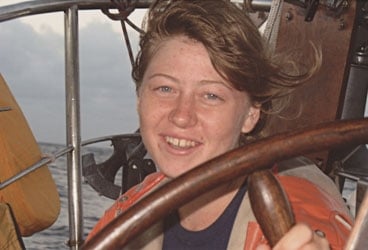
boat memories 368
The wind and waves slash about me as I sail my ship and my home, Nueva Vida, my family’s Hans Christian 43 ketch, away from New Caledonia. We sailed there from Whangerei, in New Zealand, where my parents, Tom and Kathy, and my two siblings and I stayed for the last 18 months. We left Maryland in June 2003 and slowly made our way to New Zealand via the Caribbean, the Panama Canal, French Polynesia, and Papua New Guinea. I’m 17 years old now.
Today we’re heading Nueva Vida for Vanuatu. The sky above is clear, and the sun shines strong and hot. Occasionally a wave crashes up over the coaming and into the cockpit, dousing me and the helm with a splash of cold salt water. The first time that a wave soaked me, I began to shiver. But sitting in the bright sunshine, I’m happy now that I’m saturated: The water feels good on my skin and keeps me cool.
I daydream during my turn at the helm. My thoughts play over each and every part of Nueva Vida. The wheel, the galley, the depth sounder, the anchors-each component, I discover, holds some special meaning or feeling for me. My musings seem to cluster around two especially vivid parts of the boat. One of them I love. One of them I hate. And I come to see that there’s a third part of Nueva Vida that I don’t really care about one way or another. Yet.
The Teak
The teak on which I’m sitting is warmed by the sun’s rays. The heat seeps into my skin, the warmth spreading. It has a special smell, the wood: the smell of teak oil and hard work. Its worn surface has taken many years of abuse, shown by all the dents and marks, each containing a story and a memory. As I run my hands across a long gash made by my mother many years ago, I recall its story fondly. It was caused by a 65-pound anchor being dropped and dragged across the deck as it was pulled up after a hurricane in Florida. I remember the mud and the branches entwined in the chain as we hauled it aboard. Tangled in the chain were an entire tree trunk, a bicycle, and a rake, and all dragged and scraped across the teak deck. The mud and anchor are gone now, but the scratches, like my memories, remain. I like all the mars and imperfections-they give the wood personality and history. It makes the wood ours, with our memories and our stories written into it permanently. I smile and laugh ever so quietly.
The Compass
As I steer the boat, I glance down at the compass and adjust the wheel to make sure that we’re on course. I’ve spent many hours fighting the rudder and waves to keep us sailing in the right direction. The compass wavers and dances, teasing me, shifting from southwest to west to south again. It always seems to be on the move as I chase it around and around in circles, increasing my feeling of seasickness. When I look at the compass, I feel a stir of emotions sparked by the memories that gather around it. It’s always pointed westward, as we’ve always been westward bound, always heading into the sunset-which sounds more romantic than it really is. Always heading away from our friends and family and bound for a faraway destination. Once there, we find more friends and create another home-which we’ll then leave to sail west once more. The compass on Nueva Vida is a symbol of this cycle of meeting and leaving people.
Our New Mizzen Sail
A drop of salty water falls on my jacket, but it isn’t from the sea. I wipe my eyes and adjust our course again. The sails are luffing to and fro, tearing at their fastenings, tearing to be free and reminding me to stay on my heading of 270 degrees. The sails, unlike the teak and the compass, fail to evoke any emotion in me because they lack personality and hold no memories for me. They are plain and ordinary, like any other sails. I wish we had tanbark sails or a gaff schooner rig or maybe even a square rig. The coarse, bleached-white fabric is sterile and artificial. Our mizzen sail is new. There are no creases, folds, or wrinkles to remind us of old storms or learning from mistakes made in the past. It has no stains or dirt picked up from other places about the world or patches and new seams where repairs have been made. I liked our old mizzen sail much more than this new one, but in time it, too, will have personality and characteristics all its own. Let us hope that they’ll be good ones.
When I cast my eye across the decks of Nueva Vida, I can see my memories stored in their special places. I love our teak. I dislike our compass because of the memories that are held inside it. I’m indifferent to the new mizzen, but as it luffs once again, beating against the mast, I can’t help but think that one day it, too, will surely hold memories for me of this passage from New Caledonia to Vanuatu.
Kalina Crafton wrote this essay in response to a homeschooling assignment.







